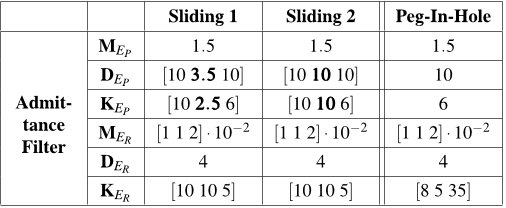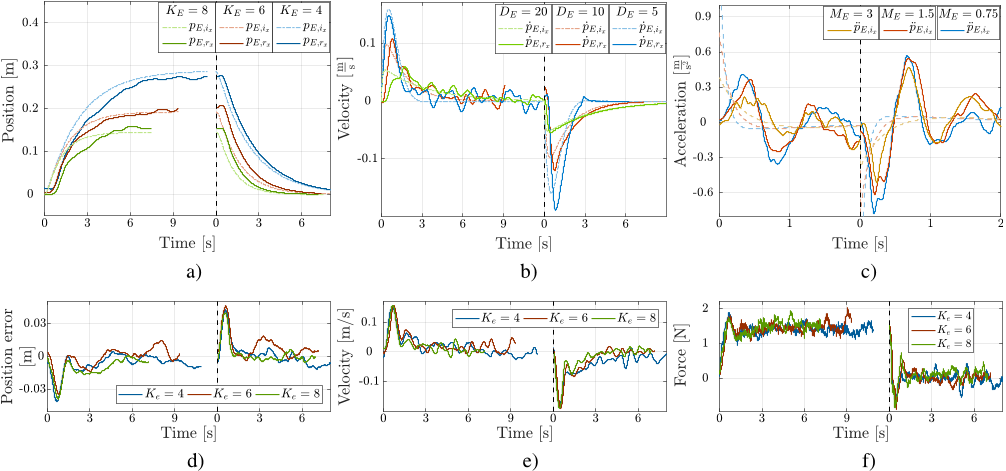




Did you find this useful? Give us your feedback





















34 citations
...However, since most of these robotic manipulators are designed for a particular platform or task, it is difficult to evaluate and compare their performance given the variety of morphologies and implementations that can be found [24], [25]....
[...]
...In any case, it is still possible to estimate and control the external forces [22], [23] and moments [24], [25] acting over a multirotor on flight....
[...]
32 citations
...Other concepts have extended the theory of fixed rotor platforms (Tognon and Franchi 2018), as interest in these systems grows....
[...]
27 citations
...We categorize existing approaches related with UAM – static-structure interaction control into the following three based on how contact forces are considered:1 1) model-based approach [2], [3], [7], [9]; 2) measurement/estimation-based approach [4], [6], [8], [15]; and 3) robust-control-based approach [16], [17]....
[...]
...For the measurement/estimation-based approach, several letters including [4], [6], [8] focus on tracking a force reference and/or tracking an end-effector reference trajectory while maintaining contact with a static surface....
[...]
23 citations
19 citations
2,305 citations
...Thus, the orientation kinematics of the robot and the end effector are then expressed by ṘR = RR[ω RR]× (1) ṘE = RE [ω EE ]×, (2) respectively, where [•]× ∈ SO(3) represents the skew symmetric matrix (Siciliano et al. (2009)) associated to vector • ∈ R3....
[...]
...(28) The (27) represents the dynamics of a 6-DoF mechanical impedance (Siciliano et al. (2009)) of inertia ME , damping DE and stiffness KE : those matrices are all positive-definite and suitably chosen in a way to impose an over-damped behavior to the system....
[...]
...respectively, where 1⁄2 × 2 SO(3) represents the skew symmetric matrix (Siciliano et al., 2009) associated with vector 2 R(3)....
[...]
...Equation (27) represents the dynamics of a 6-DoF mechanical impedance (Siciliano et al., 2009) of inertia ME, damping DE, and stiffness KE: those matrices are all positive definite and suitably chosen in a way to impose an overdamped behavior to the system....
[...]
827 citations
...2018) (Lee et al. 2010), we assume that RR,r(t) ∈ C̄ 3 and ω R,r = [RR,rṘR,r]∨, where [·]∨ represents the inverse map from SO(3) to R3....
[...]
...Following (Franchi et al. 2018) (Lee et al. 2010), we assume that RR,r(t) ∈ C̄ 3 and ω R,r = [RTR,rṘR,r]∨, where [·]∨ represents the inverse map from SO(3) to R3....
[...]
814 citations
332 citations
...…the error dynamics is exponentially convergent to the origin for any positive definite matrix L. Contact torques estimation In order to estimate the interaction torques, exerted by the external environment on the tool-tip, a momentum-based observer (De Luca and Mattone (2005)) has been designed....
[...]
...Contact torques estimation In order to estimate the interaction torques, exerted by the external environment on the tool-tip, a momentum-based observer (De Luca and Mattone (2005)) has been designed....
[...]
...More in detail, the acceleration based observer proposed by Yüksel et al. (2014a) is adopted in order to estimate the external interaction forces on the robot CoM, fR, while the external torques, τ RR are obtained by exploiting a momentum-based observer (De Luca and Mattone (2005))....
[...]
...(2014a) is adopted in order to estimate the external interaction forces on the robot CoM, fR, while the external torques, τ R are obtained by exploiting a momentum-based observer (De Luca and Mattone (2005))....
[...]
319 citations
...The second possibility is to attach an n-DoF robotic arm to the aerial platform (Muscio et al. (2016, 2017); Baizid et al. (2016); Kim et al. (2013); Tognon et al. (2017)), a solution which aims at overcoming the underactuation of the end-effector dynamics by exploiting the increased number of…...
[...]
...The second possibility is to attach an n-DoF robotic arm to the aerial platform (Baizid et al., 2016; Kim et al., 2013; Muscio et al., 2017, 2016; Tognon et al., 2017), a solution which aims at overcoming the underactuation of the endeffector dynamics by exploiting the increased number of actuators provided by the arm....
[...]